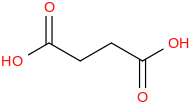Selected ATcT [1, 2] enthalpy of formation based on version 1.130 of the Thermochemical Network [3]This version of ATcT results[4] was generated by additional expansion of version 1.128 [5,6] to include with the calculations provided in reference [4].
|
Biphenyl | | Formula: C6H5C6H5 (cr) | | CAS RN: 92-52-4 | | ATcT ID: 92-52-4*520 | | SMILES: c1ccccc1c2ccccc2 | | InChI: InChI=1S/C12H10/c1-3-7-11(8-4-1)12-9-5-2-6-10-12/h1-10H | | InChIKey: ZUOUZKKEUPVFJK-UHFFFAOYSA-N | | Hills Formula: C12H10 | 2D Image: |  | | Aliases: C6H5C6H5; Biphenyl; 1,1'-Biphenyl; Bibenzene; Diphenyl; Phenylbenzene; 1,1'-Diphenyl; Lemonene; Phenador-X; PhPh; Xenene; Carolid AL; Tetrosin LY; NSC 14916; 1,1-Biphenyl; (C6H5)2 | | Relative Molecular Mass: 154.2078 ± 0.0096 |
| ΔfH°(0 K) | ΔfH°(298.15 K) | Uncertainty | Units |
|---|
| 121.6 | 97.1 | ± 1.1 | kJ/mol |
| Top contributors to the provenance of ΔfH° of C6H5C6H5 (cr)The 8 contributors listed below account for 92.5% of the provenance of ΔfH° of C6H5C6H5 (cr).
Please note: The list is limited to 20 most important contributors or, if less, a number sufficient to account for 90% of the provenance. The Reference acts as a further link to the relevant references and notes for the measurement. The Measured Quantity is normaly given in the original units; in cases where we have reinterpreted the original measurement, the listed value may differ from that given by the authors. The quoted uncertainty is the a priori uncertainty used as input when constructing the initial Thermochemical Network, and corresponds either to the value proposed by the original authors or to our estimate; if an additional multiplier is given in parentheses immediately after the prior uncertainty, it corresponds to the factor by which the prior uncertainty needed to be multiplied during the ATcT analysis in order to make that particular measurement consistent with the prevailing knowledge contained in the Thermochemical Network.
| Contribution
(%) | TN
ID | Reaction | Measured Quantity | Reference | | 43.3 | 8573.4 | C6H5C6H5 (cr,l) + 29/2 O2 (g) → 12 CO2 (g) + 5 H2O (cr,l) | ΔrH°(298.15 K) = -1493.38 ± 0.37 kcal/mol | Parks 1951 | | 24.2 | 8573.1 | C6H5C6H5 (cr,l) + 29/2 O2 (g) → 12 CO2 (g) + 5 H2O (cr,l) | ΔrH°(298.15 K) = -6247.89 ± 2.07 kJ/mol | Montgomery 1978 | | 6.8 | 8573.2 | C6H5C6H5 (cr,l) + 29/2 O2 (g) → 12 CO2 (g) + 5 H2O (cr,l) | ΔrH°(298.15 K) = -1494.20 ± 0.33 (×2.828) kcal/mol | Coleman 1966 | | 6.4 | 8573.3 | C6H5C6H5 (cr,l) + 29/2 O2 (g) → 12 CO2 (g) + 5 H2O (cr,l) | ΔrH°(298.15 K) = -1493.29 ± 0.96 kcal/mol | Mackle 1963 | | 3.7 | 8570.5 | C6H5C6H5 (g) → 12 C (g) + 10 H (g) | ΔrH°(0 K) = 10492.4 ± 5.2 kJ/mol | Karton 2021 | | 2.7 | 8572.2 | C6H5C6H5 (g) + 2 CH3 (g) → 2 C6H5 (g) + CH3CH3 (g) | ΔrH°(0 K) = 31.81 ± 1.3 kcal/mol | Ruscic G4 | | 2.6 | 8573.5 | C6H5C6H5 (cr,l) + 29/2 O2 (g) → 12 CO2 (g) + 5 H2O (cr,l) | ΔrH°(298.15 K) = -1493.4 ± 1.5 kcal/mol | Brull 1935, Cox 1970 | | 2.6 | 8573.6 | C6H5C6H5 (cr,l) + 29/2 O2 (g) → 12 CO2 (g) + 5 H2O (cr,l) | ΔrH°(298.15 K) = -1493.4 ± 1.5 kcal/mol | Stohmann 1889a, Montgomery 1978 |
| Top 10 species with enthalpies of formation correlated to the ΔfH° of C6H5C6H5 (cr) | Please note: The correlation coefficients are obtained by renormalizing the off-diagonal elements of the covariance matrix by the corresponding variances.
The correlation coefficient is a number from -1 to 1, with 1 representing perfectly correlated species, -1 representing perfectly anti-correlated species, and 0 representing perfectly uncorrelated species.
| Correlation
Coefficent
(%) | Species Name | Formula | Image | ΔfH°(0 K) | ΔfH°(298.15 K) | Uncertainty | Units | Relative
Molecular
Mass | ATcT ID | | 100.0 | Biphenyl | C6H5C6H5 (cr,l) |  | 121.6 | 97.1 | ± 1.1 | kJ/mol | 154.2078 ±
0.0096 | 92-52-4*500 | | 100.0 | Biphenyl | C6H5C6H5 (l) |  | | 113.7 | ± 1.1 | kJ/mol | 154.2078 ±
0.0096 | 92-52-4*590 | | 96.8 | Biphenyl | C6H5C6H5 (g) |  | 206.9 | 178.8 | ± 1.1 | kJ/mol | 154.2078 ±
0.0096 | 92-52-4*0 | | 15.4 | Carbonic acid | C(O)(OH)2 (aq, undissoc) |  | | -698.995 | ± 0.028 | kJ/mol | 62.0248 ±
0.0012 | 463-79-6*1000 | | 15.1 | Carbon dioxide | CO2 (g) |  | -393.110 | -393.476 | ± 0.015 | kJ/mol | 44.00950 ±
0.00100 | 124-38-9*0 | | 14.9 | Carbon dioxide cation | [CO2]+ (g) | =O](../images/456.png) | 936.090 | 936.925 | ± 0.017 | kJ/mol | 44.00895 ±
0.00100 | 12181-61-2*0 | | 13.2 | Benzoic acid | C6H5C(O)OH (cr,l) |  | -367.31 | -384.73 | ± 0.17 | kJ/mol | 122.1213 ±
0.0056 | 65-85-0*500 | | 12.8 | Succinic acid | (CH2C(O)OH)2 (cr,l) |  | -918.48 | -940.21 | ± 0.12 | kJ/mol | 118.0880 ±
0.0034 | 110-15-6*500 | | 11.9 | Phenyl | C6H5 (g) | ![c1cccc[c]1](../images/91.png) | 352.10 | 338.74 | ± 0.63 | kJ/mol | 77.1039 ±
0.0048 | 2396-01-2*0 | | 11.8 | Carbon dioxide | CO2 (aq, undissoc) |  | | -413.196 | ± 0.019 | kJ/mol | 44.00950 ±
0.00100 | 124-38-9*1000 |
| Most Influential reactions involving C6H5C6H5 (cr)Please note: The list, which is based on a hat (projection) matrix analysis, is limited to no more than 20 largest influences.
|
|
|
|
References
|
|
1
|
|
B. Ruscic, R. E. Pinzon, M. L. Morton, G. von Laszewski, S. Bittner, S. G. Nijsure, K. A. Amin, M. Minkoff, and A. F. Wagner,
Introduction to Active Thermochemical Tables: Several "Key" Enthalpies of Formation Revisited.
J. Phys. Chem. A 108, 9979-9997 (2004)
[DOI: 10.1021/jp047912y]
|
|
2
|
|
B. Ruscic, R. E. Pinzon, G. von Laszewski, D. Kodeboyina, A. Burcat, D. Leahy, D. Montoya, and A. F. Wagner,
Active Thermochemical Tables: Thermochemistry for the 21st Century.
J. Phys. Conf. Ser. 16, 561-570 (2005)
[DOI: 10.1088/1742-6596/16/1/078]
|
|
3
|
|
B. Ruscic and D. H. Bross,
Active Thermochemical Tables (ATcT) values based on ver. 1.130 of the Thermochemical Network. Argonne National Laboratory, Lemont, Illinois 2023; available at ATcT.anl.gov
[DOI: 10.17038/CSE/1997229]
|
|
4
|
|
N. Genossar, P. B. Changala, B. Gans, J.-C. Loison, S. Hartweg, M.-A. Martin-Drumel, G. A. Garcia, J. F. Stanton, B. Ruscic, and J. H. Baraban
Ring-Opening Dynamics of the Cyclopropyl Radical and Cation: the Transition State Nature of the Cyclopropyl Cation
J. Am. Chem. Soc. 144, 18518-18525 (2022)
[DOI: 10.1021/jacs.2c07740]
|
|
5
|
|
B. Ruscic and D. H. Bross
Active Thermochemical Tables: The Thermophysical and Thermochemical Properties of Methyl, CH3, and Methylene, CH2, Corrected for Nonrigid Rotor and Anharmonic Oscillator Effects.
Mol. Phys. e1969046 (2021)
[DOI: 10.1080/00268976.2021.1969046]
|
|
6
|
|
J. H. Thorpe, J. L. Kilburn, D. Feller, P. B. Changala, D. H. Bross, B. Ruscic, and J. F. Stanton,
Elaborated Thermochemical Treatment of HF, CO, N2, and H2O: Insight into HEAT and Its Extensions
J. Chem. Phys. 155, 184109 (2021)
[DOI: 10.1063/5.0069322]
|
|
7
|
|
B. Ruscic,
Uncertainty Quantification in Thermochemistry, Benchmarking Electronic Structure Computations, and Active Thermochemical Tables.
Int. J. Quantum Chem. 114, 1097-1101 (2014)
[DOI: 10.1002/qua.24605]
|
|
8
|
|
B. Ruscic and D. H. Bross,
Thermochemistry
Computer Aided Chem. Eng. 45, 3-114 (2019)
[DOI: 10.1016/B978-0-444-64087-1.00001-2]
|
|
|
|
Formula
|
|
The aggregate state is given in parentheses following the formula, such as: g - gas-phase, cr - crystal, l - liquid, etc.
|
|
|
Uncertainties
|
The listed uncertainties correspond to estimated 95% confidence limits, as customary in thermochemistry (see, for example, Ruscic [6]).
Note that an uncertainty of ± 0.000 kJ/mol indicates that the estimated uncertainty is < ± 0.0005 kJ/mol.
|
|
|
Website Functionality Credits
|
The reorganization of the website was developed and implemented by David H. Bross (ANL).
The find function is based on the complete Species Dictionary entries for the appropriate version of the ATcT TN.
The molecule images are rendered by Indigo-depict.
The XYZ renderings are based on Jmol: an open-source Java viewer for chemical structures in 3D. http://www.jmol.org/.
|
|
|
Acknowledgement
|
|
This work was supported by the U.S. Department of Energy, Office of Science, Office of Basic Energy Sciences, Division of Chemical Sciences, Geosciences and Biosciences under Contract No. DE-AC02-06CH11357.
|
|
Page generated: 04/04/2025
|







